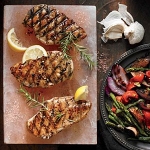The technique of cooking with salt blocks exists as more than a passing fad because it offers tastes that excite and functionality together with artistic presentation. Himalayan salt cooking block function as exceptional cooking tools to improve your culinary experience when preparing foods like scallops or steak or serving sashimi. This complete guide explores all aspects related to salt slab, which includes their definition and utilization methods alongside security precautions and care requirements, followed by multiple recipe examples.
What Is a Himalayan salt cooking block?
The Himalayan pink salt mass mined from Pakistan exists as blocks which offer food heating and chilling functionalities for cooking and serving purposes. The rich mineral content of salt creates delicate flavor and produces a beautiful visual display while cooking. The standard size for Himalayan salt cooking block measures either 8x8 or 8x12 inches while they can appear in different forms and dimensions.
Why Cook on a Salt Block?
A salt block delivers natural food seasoning through its mild salty taste, which exceeds the harshness of regular table salt.
The heated Himalayan salt cooking block keeps its temperature throughout a long cooking period.
The presentation value stands high with these blocks both during hot and cold displays.
Food that contacts Himalayan salt benefits from trace mineral contents which include potassium and iron and calcium that add depth to your dishes.
How to Use a Salt Block Safely
Less than proper handling of salt slab leads to breakage. Here are key safety tips:
Heating the block slowly until all internal moisture evaporates should be the first step before using it for the first time.
When putting the hot block onto either a cold surface or a fridge, exposure must happen gradually and not suddenly.
Heating a salt block should occur only after complete dryness to stop cracking. Let it air-dry thoroughly.
You should operate your Himalayan salt cooking block on a gas range or grill because electric stoves require a heat diffuser for proper usage.
Heating Instructions (Stovetop or Grill)
0 to 100°F: 15 minutes
100°F to 200°F: 15 minutes
200°F to 300°F: 15 minutes
300°F to 400°F: 15 minutes
Drops of water sprinkled on the surface will sizzle when they touch it as a sign of readiness.
Maintenance and Cleaning
Don't soak it. Salt dissolves in water. Wash the block using a dipped sponge or washcloth during its warm state. Clear food remains from the ceramic block by using a kitchen spatula or scrubber. Let it air dry thoroughly. The color changes do not indicate any problem because this is a natural behavior for the item.
Store in a cool, dry place. When keeping the block for a long time, use either a paper towel or cloth to enclose it.
Best Foods to Cook on a Salt Block
Great Choices:
Scallops
Shrimp
Steak
Chicken breast
Asparagus
Zucchini
Mushrooms
Thin-sliced vegetables
For Cold Dishes:
Sashimi
Carpaccio
Fresh mozzarella
Melon
Chocolate truffles
Cook only short-cooked foods along with dry items because salt blocks perform best at quick searing and chilling applications. After preheating a Himalayan salt cooking block, you should use it only to obtain fast seas and cold plating of foods.
Tips and Tricks for Success
The salt block requires only a gentle coating of oil, and you should apply it directly to your food.
Thinner cuts cook better and faster.
Check the heating temperature of your Himalayan salt cooking block until it reaches 400 degrees Fahrenheit.
Fish spatulas and metal tongs deliver perfect results when used.
The Himalayan salt cooking block needs rotation to prevent the development of hot spots.
3 Easy Himalayan salt cooking block Recipes
1. Salt Block Seared Scallops
Ingredients:
Fresh sea scallops
Olive oil
Cracked black pepper
Instructions:
Preheat the block to 400°F.
After drying the scallops down, you need to apply oil to their surface.
Sears is on the block for 2-3 minutes per side.
The combination of black pepper and lemon squeeze becomes the last finishing touch.
Using this method results in external caramelization from high heat in addition to perfect seasoning from the salt.
2. Himalayan salt cooking block Grilled Vegetables
Ingredients:
Zucchini, bell peppers, mushrooms
Olive oil
Thyme or rosemary
Instructions:
Slice veggies thinly.
Toss with oil and herbs.
The salt block will require 2-4 minutes of cooking time to grill each side.
A metal spatula serves as the best tool for working with delicate vegetables because it prevents damage.
3. Chilled Melon & Prosciutto Platter
Ingredients:
Cantaloupe or honeydew, sliced
Thin-sliced prosciutto
Fresh mint
Refrigerate the Himalayan salt cooking block for 1 hour to reach proper chilliness.
Set the prosciutto and sliced melon pieces across the block.
Garnish with mint.
The salt provides gentle flavoring to the fruit, along with an elegant and cool presentation.
Final Thoughts
Using a Himalayan salt cooking block for cooking requires some attention to detail despite being a straightforward process. Mastering this tool will lead to possession of a flexible cooking instrument that delivers superior taste and visual appeal. When serving either romantic dinners for two or serving appetizers at parties the salt block becomes an attention-grabbing centerpiece. A heating process follows gentle cleaning methods while the block completes the flavor development.






